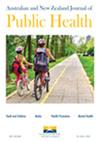An evaluation of the population uptake and contact tracer utilisation of the Covid-19 Bluetooth Exposure Notification Framework in New Zealand
IF 2.4
3区 医学
Q2 PUBLIC, ENVIRONMENTAL & OCCUPATIONAL HEALTH
Australian and New Zealand Journal of Public Health
Pub Date : 2024-11-05
DOI:10.1016/j.anzjph.2024.100197
引用次数: 0
Abstract
Objective
Our primary research objective was to assess the population uptake and contact tracer utilisation of the Bluetooth function of the New Zealand Covid Tracer App (NZCTA) throughout the pandemic.
Methods
We adopted a retrospective cohort study design using all diagnosed COVID-19 community cases from December 12, 2020 to February 16, 2022.
Results
At its height, more than 60 % of the eligible population had the Bluetooth function of NZCTA activated. However, only an estimated 2.2 % of the population was able to fully participate. Cases managed by the national case investigation service were 17 times (aRR 17.54, 95%CI: 13.02-23.90) and 9 times (aRR 9.27, 95%CI: 6.91, 12.76) more likely to generate a Bluetooth token than cases managed by local public health units during the Delta and Omicron periods, respectively.
Conclusions
The Bluetooth functionality of the NZCTA likely had a low impact on the pandemic response in NZ despite its exceptionally high levels of public uptake. The primary reason for the lack of impact was the low utilisation by contact tracers.
Implications for public health
The results highlight the need for greater consultation and collaboration with the public health sector during the development and implementation of digital contact tracing tools.
对新西兰 Covid-19 蓝牙暴露通知框架的人口吸收和接触追踪器使用情况的评估。
目标: 我们的主要研究目标是评估整个大流行期间人群对新西兰 Covid 追踪应用程序蓝牙功能的接受程度和接触者追踪器的使用情况:我们的主要研究目标是评估新西兰Covid示踪应用程序(NZCTA)蓝牙功能在整个大流行期间的人群吸收率和接触者示踪使用率:我们采用了回顾性队列研究设计,使用了2020年12月12日至2022年2月16日期间所有确诊的COVID-19社区病例:在疫情最严重的时候,超过60%的合格人群激活了NZCTA的蓝牙功能。然而,估计只有 2.2% 的人口能够完全参与。在德尔塔期和欧米克隆期,由国家病例调查服务机构管理的病例生成蓝牙令牌的可能性分别是由地方公共卫生单位管理的病例的17倍(aRR 17.54,95%CI:13.02-23.90)和9倍(aRR 9.27,95%CI:6.91-12.76):尽管公众对 NZCTA 蓝牙功能的使用率极高,但该功能对新西兰大流行应对措施的影响可能较小。缺乏影响的主要原因是接触追踪器的使用率较低:研究结果突出表明,在开发和实施数字化接触者追踪工具的过程中,需要加强与公共卫生部门的协商与合作。
本文章由计算机程序翻译,如有差异,请以英文原文为准。
求助全文
约1分钟内获得全文
求助全文
来源期刊

Australian and New Zealand Journal of Public Health
医学-公共卫生、环境卫生与职业卫生
CiteScore
4.20
自引率
5.70%
发文量
121
审稿时长
6-12 weeks
期刊介绍:
The Australian and New Zealand Journal of Public Health (ANZJPH) is concerned with public health issues. The research reported includes formal epidemiological inquiries into the correlates and causes of diseases and health-related behaviour, analyses of public policy affecting health and disease, and detailed studies of the cultures and social structures within which health and illness exist. The Journal is multidisciplinary and aims to publish methodologically sound research from any of the academic disciplines that constitute public health.
 求助内容:
求助内容: 应助结果提醒方式:
应助结果提醒方式:


